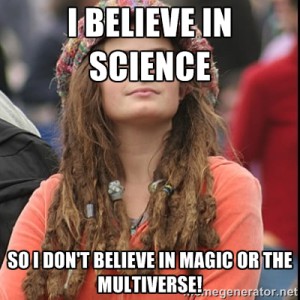Ordered from the more to less serious…
- On the geometric Langlands front, there’s video posted today of this talk by Dennis Gaitsgory. Michael Harris has already commented here about the local geometric Langlands conjecture in terms of 2-categories that Gaitsgory discusses. Today’s arXiv listings have a new paper on geometric Langlands by Witten, which begins with his version of a formulation relating the categorical point of view and quantum field theory.
I wrote recently here about a talk by Jacob Lurie that alluded to an explanation of this categorical equivalence for the simplest case of G invertible complex numbers (rather than the case of G a general semi-simple Lie group that Gaitsgory and Witten are discussing). I’m still far from being enlightened concerning that simplest case, but have learned a lot from Alexander Polishchuk’s Abelian varieties, theta functions and the Fourier transform which I take as treating the global versions of this equivalence. - Witten has been busy, with yesterday’s arXiv listings including a 429 page paper with Gaiotto and Moore (does anyone know of a longer hep-th paper that’s not a review article?). There’s also a companion shorter summary paper. The motivation here is again a categorical picture expressed in terms of quantum field theory models, but for more insight you’ll need to find someone more expert than me on this topic.
- Strings 2015 will be held in Bangalore in a couple weeks. Talks titles are now available, so you can see what the hot topics in the “string theory” community are. Of Gaiotto, Moore and Witten, only Witten will be speaking. Perhaps his talk on An Overview of Worldsheet and Brane Anomalies will shed some light on the 429 page paper.
- On the Mochizuki/abc front, hopes rest on a planned workshop at Oxford this December. Fesenko has circulated a letter about the workshop, which gives suggestions about how to approach the subject.
- Via Chandan Dalawat’s Google+ page I found out about this autobiographical piece by Misha Gromov. One thing it made clear to me is why I couldn’t get anything out of the couple times I’ve heard him lecture.
Being trivial is our most dreaded pitfall: you say stupid things, not original things, outrageously wrong things – all will be forgotten when the dust settles down. But if you pompously call a+b=c “Theorem” in your paper, you will be forever remembered as “this a+b guy”, no matter you prove bloody good theorems afterwords…
I was introduced to the idea on September 1st 1960 at the then Leningrad University when our analysis professor Boris Mikhailovich Makarov said to me after our first calculus class – he expressed this in somewhat metaphorical terms – that I should’ve kept my mouth shut unless I had something non-trivial to say.
Further encouraged by my teachers and fellow students, I tried to follow his advice and, apparently, have succeeded – I hear nothing disrespectful about my mouth for the last 10-20 years. Strangely, this does not make me feel a lot happier.
“Trivial” is relative. Anything grasped as long as two minutes ago seems trivial to a working mathematician.Another thought this raises is that I’ve just spent the last 3 years of my life writing something trivial…
- I really like Jordan Ellenberg’s suggestion of Cold Topics Workshops.
- Mathematics makes it into the Guardian with an article about mathematical modeling.
- With the LHC inactive, some LHC physicists have had to spend their time studying plots (trigger warning, and NSFW).
Update: One more, far more serious than anything above. Sabine Hossenfelder brings up an important and rarely discussed topic here.



